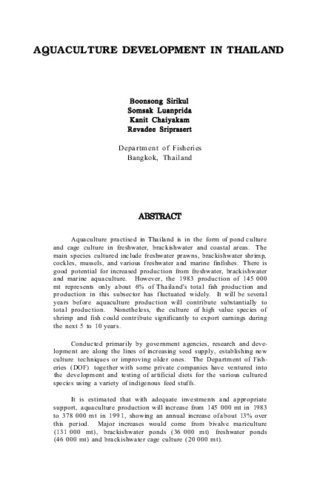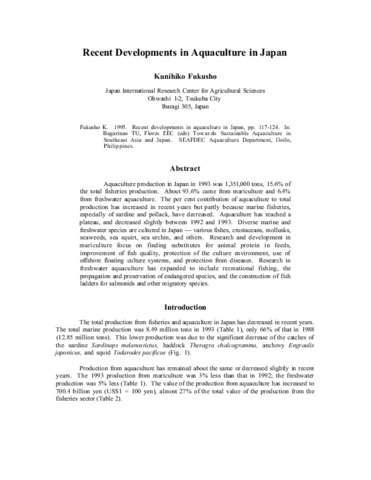Brunei Darussalam: Status of implementation of the resolution and plan of action on aquaculture.
Share
Abstract
The aquaculture industry in Brunei Darussalam consists of cage culture of marine fishes and pond culture of freshwater and marine shrimps. The government has established various facilities to promote, facilitate and sustain the development of the industry so it can play a vital role in achieving the overall food production target and diversification of the country s food supply. The development of technology on marine fish seed production and culture of high commercial-value marine fish species, especially the green and red grouper are one of the priorities of the Department of Fisheries (DoF). Moreover, the development of potential species for export and improvement of aquaculture facilities will also be given due attention. The country is now focusing on the following: (1) production not only of marine fishes but also of freshwater and ornamental fishes since most of these are imported from the neighboring countries; (2) commercial production of specific pathogen free (SPF) Litopenaeus stylirostris; and (3) development of off-shore cage culture industry.
Suggested Citation
Metali, A. R. (2011). Brunei Darussalam: Status of implementation of the resolution and plan of action on aquaculture. In B. O. Acosta, R. M. Coloso, E. G. T. de Jesus-Ayson, & J. D. Toledo (Eds.), Sustainable aquaculture development for food security in Southeast Asia towards 2020. Proceedings of the Regional Technical Consultation on Sustainable Aquaculture Development in Southeast Asia Towards 2020 (pp. 61-65). Tigbauan, Iloilo, Philippines: SEAFDEC Aquaculture Department.
Subject
aquaculture  ; aquaculture development
; aquaculture development  ; aquaculture economics
; aquaculture economics  ; cage culture
; cage culture  ; culture effects
; culture effects  ; feeds
; feeds  ; fish culture
; fish culture  ; fish diseases
; fish diseases  ; Fish meal; food security
; Fish meal; food security  ; freshwater aquaculture
; freshwater aquaculture  ; Marine aquaculture; national planning
; Marine aquaculture; national planning  ; seed (aquaculture)
; seed (aquaculture)  ; shrimp culture
; shrimp culture  ; sustainability
; sustainability  ; Brunei Darussalam
; Brunei Darussalam
 ; aquaculture development
; aquaculture development  ; aquaculture economics
; aquaculture economics  ; cage culture
; cage culture  ; culture effects
; culture effects  ; feeds
; feeds  ; fish culture
; fish culture  ; fish diseases
; fish diseases  ; Fish meal; food security
; Fish meal; food security  ; freshwater aquaculture
; freshwater aquaculture  ; Marine aquaculture; national planning
; Marine aquaculture; national planning  ; seed (aquaculture)
; seed (aquaculture)  ; shrimp culture
; shrimp culture  ; sustainability
; sustainability  ; Brunei Darussalam
; Brunei Darussalam
Related items
Showing items related by title, author, creator and subject.
-
Aquaculture development in Thailand
Sirikul, Boonsong; Luanprida, Somsak; Chaiyakam, Kanit; Sriprasert, Revadee (Aquaculture Department, Southeast Asian Fisheries Development Center, 1988)Aquaculture practised in Thailand is in the form of pond culture and cage culture in freshwater, brackishwater and coastal areas. The main species cultured include freshwater prawns, brackishwater shrimp, cockles, mussels, ... -
Aquaculture development in Malaysia
Liong, Pit Chong.; Hanafi, Hambal Bin.; Merican, Zuridah Osman.; Nagaraj, Gopinath. (Aquaculture Department, Southeast Asian Fisheries Development Center, 1988)Malaysia is a fish-consuming country with fish representing 60% of a total animal protein intake. At an annual per capita consumption of 32 kg some 560 000 mt of fish is required for the projected of 17.5 million people ... -
Recent developments in aquaculture in Japan
Fukusho, K. (Aquaculture Department, Southeast Asian Fisheries Development Center, 1995)Aquaculture production in Japan in 1993 was 1,351,000 tons, 15.6% of the total fisheries production. About 93.6% came from mariculture and 6.4% from freshwater aquaculture. The per cent contribution of aquaculture to total ...




